Abstract
Long-distance water transfer is a critical engineering measure to rectify disparities in water resource distribution across regions. The effective operation and safety of such projects are paramount to their success, as localized issues can have cascading consequences, potentially disrupting the entire network. Conventional ground-based monitoring methods have limitations in measuring the deformation of large-scale structures. In this paper, InSAR is employed to monitor the deformation of the Shuangwangcheng (SWC) Reservoir, which features a long embankment dam as part of the South-to-North Water Diversion Project in China. We utilize data from both Sentinel-1 and TerraSAR-X satellites to derive 7-year deformation. Results reveal that the entire dam experiences continuous subsidence, with the maximum deformation in the line-of-sight direction measuring ~160 mm. While minor differential settlements are noted in different sections of the dam, the gradient is not significant due to the dam’s substantial length. The InSAR deformation results from multiple geometries demonstrate good consistency, with the highest correlation observed between the Sentinel-1 ascending and descending datasets, exceeding 0.9. Validation against the GNSS observations of the three sites on the SWC Dam shows the accuracy of InSAR displacements is ~8 mm. Water level changes do impact deformation, but consolidation settlement appears to be the primary controlling factor during the monitoring period. This study underscores the potential of InSAR in long-distance water transfer projects and highlights that spatially continuous deformation is the most significant advantage.
1. Introduction
Water is a fundamental prerequisite for all forms of development. Whether it is in agriculture, industry, or sustaining human life itself, access to clean and sufficient water resources is essential for progress and growth in any society [1]. To overcome the problem of uneven distributions of water resources, long-distance water transfer initiatives emerge as a pivotal solution, such as the California State Water Project in the United States [2] and the South-to-North Water Diversion (SNWD) Project in China [3]. Long-distance water transfer projects encompass a series of interconnected hydraulic structures, demanding an elevated level of system safety. A critical failure at any juncture within the system has the potential to disrupt the entire water supply network. Typically, these projects traverse densely populated and economically vibrant regions, amplifying the repercussions of any potential breakdown. Consequently, the surveillance of safety measures within long-distance water transfer systems assumes paramount importance. Such monitoring endeavors are instrumental in enhancing water supply reliability, safeguarding project integrity, and securing the well-being and property of individuals residing along the project’s trajectory.
Conventional ground monitoring techniques, such as levelling, total station, and GNSS measurements, indeed provide high precision. However, they are restricted by their limited observation range and vulnerability to external environmental factors, resulting in a lower monitoring efficiency. These limitations make them less suitable for the extensive, simultaneous observation applications required for monitoring long-distance water transfer projects. Synthetic Aperture Radar Interferometry (InSAR), as an active remote sensing technology, is less susceptible to conditions like clouds and rain [4]. It enables the acquisition of topographic and deformation across broad areas, offering a high spatial resolution at a relatively low cost. Over the past three decades, InSAR has witnessed rapid advancement [5,6,7,8] and has found widespread application in various domains, including earthquake studies [9], urban subsidence analysis [10,11,12], landslide monitoring [13,14], and mining assessments [15,16]. In recent years, numerous countries and organizations have either launched or have plans to launch multiple SAR satellite missions, which are poised to further propel the development and application of InSAR technology.
Researchers worldwide have harnessed InSAR technology for the deformation monitoring of water engineering. Hanssen et al. [17] conducted deformation monitoring on dikes in the Netherlands using the Persistent Scatterer Interferometry (PSI) method. Their study revealed that the supervised classification of potential coherent scatterers significantly increased the sampling density of PS targets on linear structures such as dikes. Liao et al. [18] utilized TerraSAR-X images to analyze landslides in the Three Gorges area through the time series InSAR method. They found a nonlinear relationship between the deformation and water level, highlighting that fluctuation in the water level at the Three Gorges Dam is a major factor triggering landslides in the region. Voege et al. [19] utilized both ascending and descending orbit datasets from ERS satellites covering the Svartevatn Dam in Norway. They utilized the SBAS method for deformation monitoring and stressed the significance of combining data from both ascending and descending orbits for effective dam monitoring. Milillo et al. [20] conducted a comprehensive study on the continuous instability of the Mosul Dam in Iraq using images from different time periods, including data from the ENVISAT, COSMO-SkyMed, and Sentinel-1 satellites. The results indicated that the dam experienced significant deformation from 2004 to 2010, followed by a period of stabilization from 2012 to 2014. However, after the cessation of grouting operations in August 2014, the deformation of the dam accelerated once again. Emadali et al. [21] conducted a study on the deformations occurring at the Masjed-Soleyman Dam in Iran, adopting the X-band TerraSAR-X satellite data. The study emphasized that, compared to traditional monitoring methods, the use of high-resolution SAR images enabled the identification of a greater number of deformation areas on both the crest and downstream face of the dam. Al-Husseinawi et al. [22] performed an assessment of the post-earthquake stability of the Darbandikhan Dam in Iraq by integrating data from GPS, levelling, and Sentinel-1 satellite observations. The dam maintained relatively good stability from October 2014 to November 2017, while a continuous subsidence at the dam’s crest was observed during the period following an earthquake. Li et al. [23] conducted an analysis of consolidation settlement in the Gongming Dam, China, utilizing datasets from both TerraSAR-X and COSMO-SkyMed. The study found that, in comparison to the TerraSAR-X dataset, the COSMO-SkyMed dataset underestimated the deformation occurring on the top of the dam slope. Xie et al. [24] conducted a time series InSAR analysis of the Xe Pian-Xe Namnoy Dam in Laos using Sentinel-1 satellite images. The study discussed the deformation mechanisms leading to the dam’s collapse in 2018. Factors such as water pressure, soil consolidation, thermal expansion, sinkage, and lateral extrusion were considered as primary contributors to the failure of the saddle dam. Xiao et al. [25] conducted an investigation into the 2020 Sardoba Dam failure in Uzbekistan, adopting multi-geometry Sentinel-1 SAR data. Results uncovered the pre-failure deformation that occurred on the dam between 2017 and 2020. The differential settlement near the failure section reached 60 mm, indicating the presence of internal erosion within the embankment. The study provided valuable insights into the factors leading to dam failure and highlighted the importance of continuous monitoring for dam safety. Mishra et al. [26] obtained line-of-sight (LOS) deformation data of the Baglihar Dam Reservoir and surrounding areas using the PSI technique. Tropical Rainfall Measuring Mission (TRMM) data were utilized in conjunction to analyze the temporal correlation between displacement and local rainfall. Zhu et al. [27] derived the horizontal and vertical displacements of the Xingguang Village landslide located on the Xiluodu Reservoir from ALOS-2 PALSAR ascending and descending data. Through on-site investigations and UAV photography verification, the study revealed that reservoir storage led to soil softening and pressure variations induced by water level fluctuations, contributing to a decrease in the slope stability. Li et al. [28] monitored unstable slopes in the Xiluodu Reservoir area, China, before and after impoundment using ALOS-1, ENVISAT ASAR, and Sentinel-1. The study assessed the evolving trends of unstable slopes based on long-term changes in the deforming area with the reservoir water level.
In this study, we direct our attention to an important storage reservoir of China’s Eastern Route of the SNWD Project, namely the Shuangwangcheng (SWC) Reservoir, situated in Shouguang City, Shandong Province, China. Differing from reservoir dams in previous research, the SWC Reservoir is a prototypical plain reservoir characterized by an embankment spanning 9.6 km. Consequently, the conventional approach of establishing observation cross-sections at intervals of 50–100 m on the dam surface, as typically applied to mountainous reservoirs, is impractical here. In engineering practice, monitoring sections for plain reservoir dams are typically spaced approximately 1 km apart, a density that is evidently inadequate. Yet, it is important to note that major safety incidents in dams often arise from localized damage to a vulnerable component, known as the “short board effect”. To address this challenge, the spatially continuous deformation data provided by InSAR emerge as a potent solution. In this paper, we leverage both C-band Sentinel and X-band TerraSAR data to perform multi-temporal InSAR-based deformation monitoring of the SWC Reservoir. We assess the accuracy of our findings against GNSS monitoring results obtained from 1 May 2017, to 8 December 2017 and delve into the underlying causes of deformation in relation to reservoir water levels. We also analyzed the deformation of the SWC Reservoir embankment before and after the emergency storage task during the autumn flood of 2021.
This paper has the following structure: Section 2 describes the study area and the data sources used. In Section 3, details of the InSAR data processing strategies implemented are given. Section 4 presents the results of the InSAR deformation time-series analysis, assesses the imaging geometry, and validates the results using GNSS observations. Section 5 discusses the impact of water level changes on deformation and examines the dam deformation patterns during emergency water storage in the 2021 autumn flood. Finally, concluding remarks are drawn in Section 6.
2. Study Area and Datasets
2.1. Study Area
To address water scarcity in North China and optimize regional water resource allocation, China initiated the South-to-North Water Diversion Project in 2002, marking the world’s largest long-distance water transfer endeavor. The SNWD Project encompasses three key segments: the Eastern Route Project (ERP), the Middle Route Project, and the Western Route Project. While the Western Route remains in planning, Phase I of the Eastern Route and Central Route became operational in November 2013 and December 2014, respectively. As of May 2023, the two routes have cumulatively transferred more than 62 billion cubic meters of water to the north, benefiting more than 280 counties and urban areas in 42 large- and medium-sized cities along the routes and directly benefiting a population of more than 150 million people [29]. This significant effort has played a pivotal role in addressing the long-standing problem of excessive groundwater depletion in North China [30,31].
The ERP sources its water from Jiangdu, Yangzhou City, China, downstream of the Yangtze River. It leverages the Beijing-Hangzhou Grand Canal to link various lakes equipped with flood control and water storage functions, such as Hongze Lake, Luoma Lake, Nansi Lake, and Dongping Lake. Upon exiting Dongping Lake, the water is divided into two directions for distribution: one route extends north, crossing the Yellow River near Weishan Mountain, and supplies water to Hebei Province and Tianjin City. The other route proceeds east via the Jiaodong water transmission mainline, delivering water to the cities of Yantai and Weihai. Spanning over 1400 km, the ERP constitutes a comprehensive water system interconnecting numerous water infrastructure facilities along its route [32]. These include 13 pumping stations, four lakes, and three newly constructed reservoirs. The dependable and consistent operation of these facilities is intricately linked with the water security of residents along the route.
Located in Shouguang, Weifang City, Shandong Province, China, the SWC Reservoir is one of the three newly built essential plain reservoirs of the ERP (Figure 1a,c). It is classified as a medium-sized plain reservoir with a maximum water level of 12.5 m, a total storage capacity of 61.5 million m3, and a regulated storage capacity of 53.2 million m3. The length of the dam axis is 9.636 km, and the width of the dam crest is approximately 7.5 m. The primary engineering structures of the SWC Reservoir include embankments, water channels, water supply tunnels, spillway tunnels, sluices, pumping stations, and culverts. The project commenced in August 2010 and was completed in June 2013, with water diversion operations initiated thereafter.
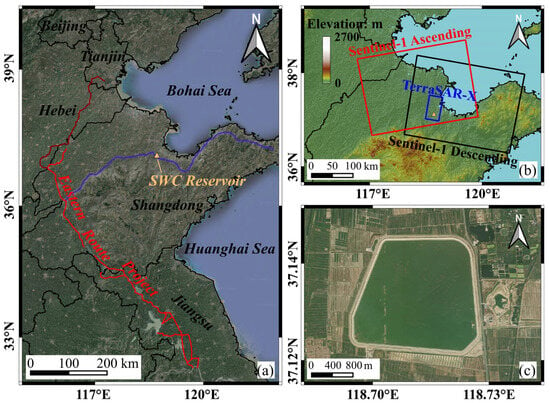
Figure 1.
(a) The geographical locations of the SWC Reservoir, ERP, and Jiaodong Water Diversion Project (Jiaodong WD). The red line denotes the ERP, the blue line represents the Jiaodong WD, and the yellow triangle indicates the SWC Reservoir. (b) Coverage of the satellite images overlaid on an elevation background map. The red and black polygons denote the coverage of Sentinel-1 ascending and descending frames, respectively. The blue polygon represents the coverage of the TerraSAR-X frame. (c) Optical image of the SWC Reservoir.
Figure 2 provides an overview of the reservoir and its surrounding infrastructures, including the GNSS monitoring sites, a pump station, the wave protection wall, and lamps. Influenced by its own gravitational forces, water pressure, and the consolidation of the filling materials, the dam will continue to deform for a period of time after it is built. In the case of the SWC Reservoir, which has been in operation for 10 years following its reconstruction in 2013, routine inspections have identified surface cracks on the dam (Figure 2b). Engineers are particularly concerned with understanding the nature of the dam deformation and the stage of consolidation settlement is it undergoing.
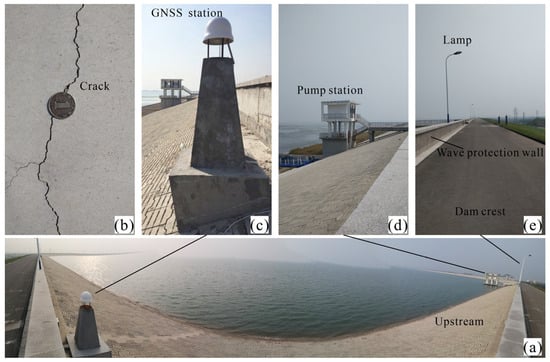
Figure 2.
Photos showing the site conditions of Shuangwangcheng Reservoir: (a) a panoramic view of the reservoir; (b) cracks found on the dam during fieldwork; (c) GNSS monitoring site on the dam; (d) pump station; (e) wave protection wall and the lamp.
2.2. Datasets
In this study, we utilized a collection of SAR images acquired from both the C-band Sentinel-1 satellite operated by European Space Agency (ESA) and X-band TerraSAR-X satellite operated by German Aerospace Center (DLR) for the long-term deformation monitoring of the SWC Reservoir (Figure 1b). The dataset comprises 177 ascending Sentinel-1 images, 135 descending Sentinel-1 images, and 23 descending TerraSAR-X images. Further details about the SAR image dataset are provided in Table 1.

Table 1.
Main parameters of SAR datasets.
To mitigate the influence of orbit errors on interferograms, we applied the precise orbit information provided by the European Space Agency in the data processing. The Copernicus DEM with a resolution of 30 m was employed for topography phase removal and geocoding [33].
3. InSAR Data Processing
The single-look complex (SLC) data were first registered to a standardized image coordinate, and, subsequently, an interferogram set was generated with a short baseline strategy. The deformation results were obtained through time series analysis and then were integrated with external observations for comprehensive deformation analysis. The data processing workflow is represented in Figure 3.
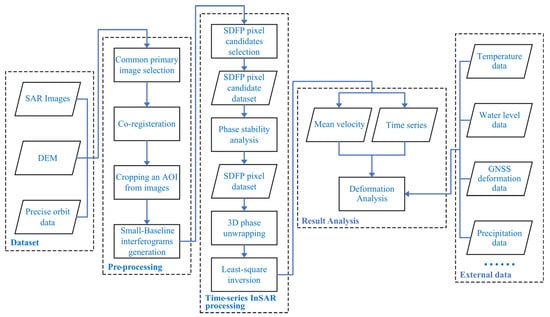
Figure 3.
Flowchart of the time series InSAR for dam deformation analysis.
3.1. Pre-Processing
A common primary image was first selected as the reference for each dataset, and then all other images were co-registered and resampled to this reference. Specifically, the SAR image acquired on 16 July 2019 was chosen as the common reference for the Sentinel-1 ascending dataset, the image on 10 July 2019 was chosen for the Sentinel-1 descending dataset, and the image on 1 October 2016 was chosen for the TerraSAR-X dataset. Each image was paired with a maximum of six others, with a temporal baseline threshold of 180 days for the interferometric processing. This resulted in the generation of a total of 1033 interferograms for the Sentinel-1 ascending dataset, 777 for the Sentinel-1 descending dataset, and 100 for the TerraSAR-X dataset, which were then used for further time series analysis. The temporal and spatial baselines are shown in Figure 4.
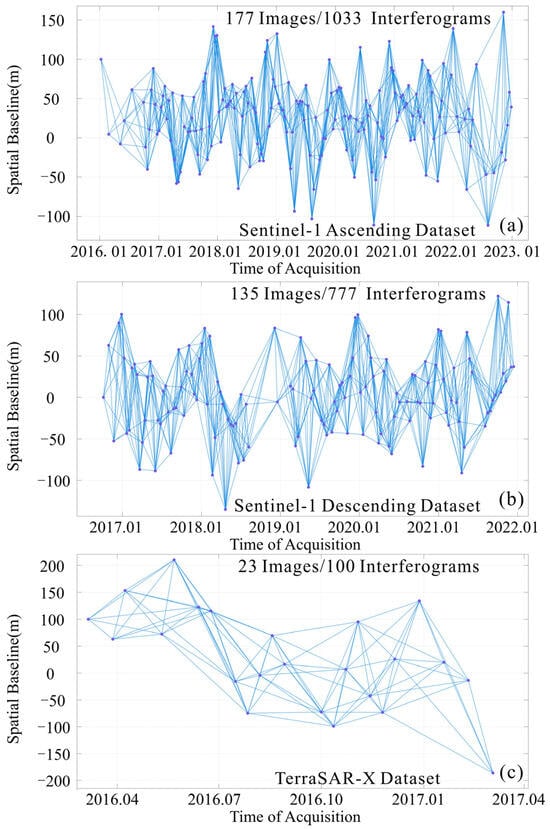
Figure 4.
Spatial and temporal baselines of the interferograms generated for each dataset for time series analysis: (a) Sentinel-1 ascending dataset; (b) Sentinel-1 descending dataset; (c) TerraSAR-X dataset.
3.2. Time Series InSAR Processing
We performed time series InSAR analysis within the StaMPS/MTI (version 4.1b) framework [7], incorporating several enhanced strategies. The coherent pixel selection involved the analysis of both amplitude and phase stability [34]. Targets candidates with an amplitude dispersion of less than 0.4 were firstly identified. Subsequently, we eliminated all spatially correlated phase components through a combination of low-pass filtering and fringe rate estimation [35]. Candidates for analysis were ultimately confirmed based on a threshold for standard deviation of the interferometric phase time series, requiring it to be less than 0.8 rad. All the wrapped phases were initially unwrapped by the minimum cost flow (MCF) algorithms [36], and then phase unwrapping errors were detected by phase closure [37]. The suspected unwrapped interferograms were refined with the SNAPHU unwrapping method [38]. Finally, the least squares method was applied to eliminate topographic errors by analyzing the time series unwrapped phase relative to the perpendicular baseline. A stable area located in the southwest of the reservoir has been designated as the reference area.
3.3. Two-Dimensional Deformation Decomposition
The deformation obtained by single-track SAR images represent the displacement along the satellite line of sight, i.e., the projection of horizontal and vertical displacements of ground targets in the LOS direction. By analyzing the imaging geometry [39], we can derive the following equation:
where is the LOS deformation, is the incidence angle of the radar, is the heading angle of the satellite, and , , and are the three-dimensional true displacements of ground targets: north–south, east–west, and up–down. The satellite operates in a polar orbit; thus, InSAR measurements are insensitive to ground motions in the N-S direction. Ignoring the N-S displacement component, the vertical and horizontal E-W displacements can be derived from the following equation:
where and represent the incidence angles, and are the heading angles, and and are the LOS deformations of the ascending and descending datasets, respectively.
4. Results
4.1. Imaging Geometry Analysis
The SAR satellites have a side-looking imaging geometry. When combined with the shape of reservoir dams, the local geometric relationship varies due to differences in local incidence angles. Figure 5a is a demonstration of the imaging geometries of the ascending and descending SAR satellite orbits.
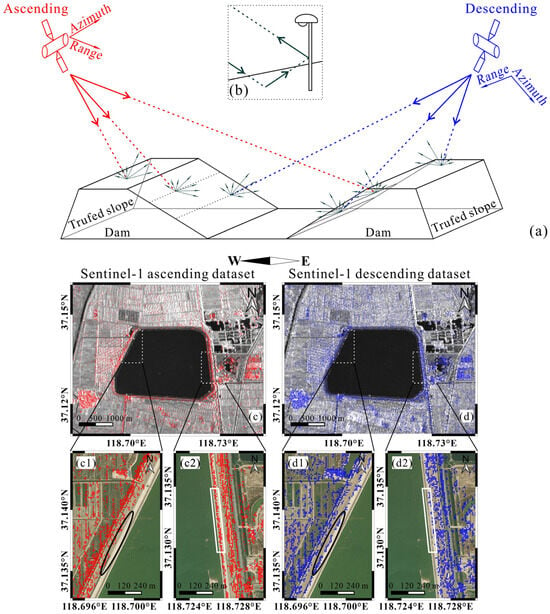
Figure 5.
(a) Demonstration of the embankment imaging geometries from the ascending and descending SAR satellite orbits. (b) The lamps on the dam top act as corner reflectors in SAR images. (c,d) are the selected targets showing on the SAR amplitude images. (c1,c2,d1,d2) provide local zoomed views with scatterers on the optical remote sensing images; the black ellipses and white polygons highlight areas on both sides of the dam where the distribution of scatterers exhibits significant differences.
The top of the SWC Dam is a road paved with asphalt concrete. When radar waves transmitted from the satellite reach the dam crest, they undergo approximate specular reflection, which makes it challenging for the sensor to receive the echo signal effectively. However, the lamps and wave protection walls situated on the dam crest form dihedral angles with the road surface. This geometric configuration leads to multiple reflections of the microwave signals, effectively transforming these features into corner reflectors (see Figure 5b). As a result, only a limited number of pixels on the dam top were identified as coherent targets due to this unique geometry.
The distributions of coherent pixels selected from Sentinel-1 ascending and descending paths are presented in Figure 5c,d, respectively. The impact of different imaging geometries on the density of scatterers can be observed in the local zoomed views (Figure 5(c1–d2)). At the same location on the west side of the dam (Figure 5(c1,d1)), the number of scatterers selected from Sentinel-1 descending geometry is significantly greater than the ascending geometry. Conversely, in ascending geometry, the density of scatterers on the east side of the dam (Figure 5(c2,d2)) is much higher than in descending geometry. In the downstream, both geometries have few targets. This scarcity of coherent pixels on the downstream slope of the SWC Reservoir can be attributed to the fact that it is covered with turf. This turf cover leads to low coherence in the interferograms, explaining the limited number of pixels that could be selected in this region.
The number of targets obtained on the upstream of the west embankment dam is lower than those on the east dam for the Sentinel-1 ascending path (as shown in Figure 5c). However, the results obtained from the Sentinel-1 descending dataset exhibit the opposite situation, with more targets on the west compared to the east side (as shown in Figure 5d). This variation is due to the local incidence differences between the LOS directions and the upstream of the embankment dams. For the ascending path, the incidence angle is larger on the west bank than on the east side, which causes a more significant portion of radar waves to reflect away from the satellite. In contrast, a smaller incidence angle on the west bank results in more targets being detected than on the east side for the descending track.
4.2. InSAR Deformation Results
Figure 6 illustrates the mean velocity results derived from the InSAR time series analysis. In the study area of the SWC Reservoir, approximately 60,000 coherent pixels were selected for the Sentinel-1 ascending dataset, while the Sentinel-1 descending dataset yielded around 97,000 coherent pixels. The TerraSAR-X ascending dataset detected a higher number of targets, amounting to about 133,000. This higher detection rate is attributed to the superior resolution of TerraSAR-X satellite data. The X-band SAR has a shorter wavelength, making the signals more susceptible to decorrelation compared to C-band Sentinel-1 data. Consequently, the reservoir’s surrounding agricultural areas exhibit a sparser distribution of measurement points. In contrast, on dam infrastructures where backscattering is more pronounced, the measurement density is significantly higher. Since the selected targets must consistently be present in all interferograms, the Sentinel-1 ascending dataset with more interferograms actually forms a stricter target selection criterion, which leads to rejecting more pixels. Despite this, the InSAR results offer a higher information density and improved spatial continuity, surpassing the capabilities of traditional ground-based dam monitoring methods, such as levelling and GNSSs.
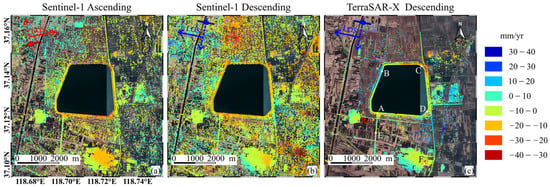
Figure 6.
Mean velocity of LOS deformation from (a) Sentinel-1 ascending, (b) Sentinel-1 descending, and (c) TerraSAR-X descending datasets. Positive values indicate motion towards the satellites; the red pentagram located on the southwest side of the reservoir represents the reference area. Six typical locations are marked as A–F.
We plot the InSAR deformation time series results at six typical sites, as depicted in Figure 7. Of these, four positions, labeled A to D, are located on the SWC Reservoir Dam. They are respectively positioned near the inlet pumping station, the leakage tunnel, the northeast corner of the dam, and in close proximity to the water supply tunnel. It is worth noting that locations A, B, and D have culverts that pass through the dam structure. Point C, in particular, exhibits noticeable deformation according to the InSAR results. In addition to the dam locations, two other points were included. Location E is situated along the water supply channel on the reservoir’s southern side, while F is located in Koujiawu Village. These points offer a diverse range of positions for monitoring and analyzing deformation.
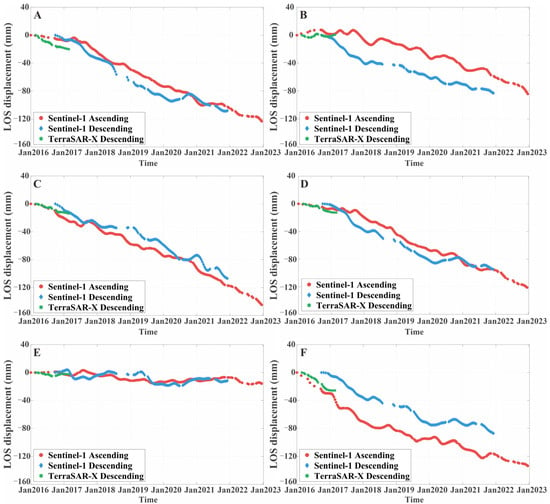
Figure 7.
Deformation time series of the Sentinel-1 ascending and descending and TerraSAR-X descending datasets for selected sites (A–F), whose locations are marked in Figure 6c.
The SWC Reservoir Dam is undergoing settlement, with the most significant deformation observed near point C in the northeast corner. Over the course of seven years, the cumulative LOS deformation at this location has reached approximately 160 mm. Locations A and D exhibit displacement amounts that are roughly equivalent, each registering at about 120 mm. In contrast, point B, located on the west bank of the reservoir, demonstrates the smallest deformation among the four points, measuring around 80 mm. These data reveal relatively minor variations in settlement across different sections of the dam. With the deformation rate map, we can describe the overall deformation patterns on the dam: the northeastern, eastern, and southern sections of the embankment dam have undergone substantial subsidence rates, while the northwestern side displays the least deformation. Due to the dam’s considerable length, the spatial gradient of this differential deformation is relatively slight. Notably, significant deformation gradients have the potential to induce cracks in the dam [25]. The superior spatial resolution offered by InSAR facilitates the study of differential settlement gradients, a task that is unfeasible with traditional monitoring methods, which typically establish monitoring sections at one-kilometer intervals for plain reservoir dams.
Points E and F, located to the southern side of the reservoir, exhibit different deformation behaviors. Point E, situated on the reservoir diversion channel, has remained relatively stable over a period of seven years, with no significant deformation observed. In contrast, Point F, located in Koujiawu Village, has experienced significant subsidence, accumulating a total settlement of 130 mm. This ground subsidence is a consequence of groundwater exploitation to fulfill the production and residential needs of the local populace. Shouguang City, where the reservoir is situated, lies in an area known for the excessive exploitation of groundwater resources [40,41,42]. In response to this issue, the city has implemented a series of control measures in recent years. The establishment of the SWC Reservoir and the SNWD Project has also improved access to transferred water, thus reducing the dependence on local groundwater resources.
In the case of earth-rock dams, deformation is typically more significant during the construction phase and early after completion. Subsequently, the dam enters a relatively stable period, and the deformation process gradually decelerates. This transition marks the conclusion of the primary consolidation phase and the commencement of the secondary consolidation stage for the earth-rock dam. The deformation time series results of the SWC Reservoir Dam reveal that it has undergone an approximately linear deformation process over the past seven years. While short-term fluctuations are observed, the overall deformation rate remains relatively consistent. This suggests that the SWC Reservoir Dam is still in the primary consolidation stage. InSAR’s high temporal resolution and monitoring continuity provide valuable insights into the time-varying characteristics of earth-rock dam deformation.
4.3. Two-Dimensional Deformation
To obtain the two-dimensional deformation, we resampled the LOS deformations from both orbits to a unified geographic grid with cell sizes of 15 15 . Linear interpolation was applied to fill the time series of each imaging time. The decomposition process was carried out as described in Section 3.3. The number of targets on the dam is reduced to 18,000 after resampling. Despite the lower density compared to the original results, the spatial detail and resolution still exceeds that of conventional ground-based measurement methods (e.g., levelling and GNSSs).
From Figure 8a, it can be observed that the dam of the SWC Reservoir does not exhibit significant horizontal displacements on any of the four sides. The deformation rates are generally between −10 and 10 mm/year, showing no noticeable variations. The dam remains stable in the horizontal E-W direction.
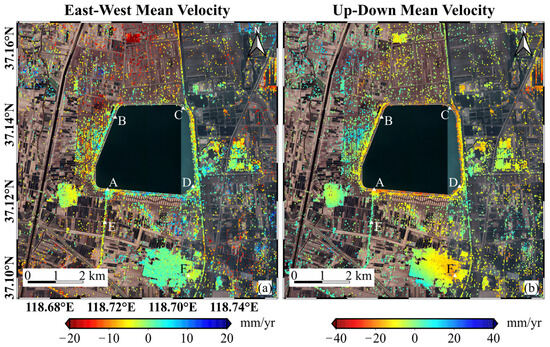
Figure 8.
(a) The horizontal east–west mean displacement velocity map, with positive values indicating eastward movement. (b) The vertical up–down mean displacement velocity map, with negative values indicating settlement. A–F represent the six locations marked in Figure 6c.
Compared to the horizontal displacement, the vertical deformation velocity shown in Figure 8b is more pronounced. Even in areas with relatively fewer targets on the west and north sides of the dam, evident settlement can be observed. The settlement distribution in the SWC Reservoir Dam reveals significant subsidence at the crest and upstream, with comparatively minor subsidence at the base.
In general, the horizontal displacement of a dam is relatively smaller than the vertical settlement. If the vertical settlement of the dam is within an acceptable range, the horizontal displacement is also considered safe [43]. Therefore, here we focus more on the vertical deformation of the SWC Reservoir Dam.
4.4. Correlation Analysis of InSAR Datasets
What InSAR measures is the projection of the three-dimensional ground motion into the satellite LOS direction. The force acting on different sections of the dam varies, leading to variations in horizontal movement. Consequently, the patterns of deformation time series at the same position differ between InSAR ascending and descending results. Notably, for earth-rock dams, horizontal deformation is smaller than vertical deformation [43]. Therefore, by neglecting horizontal movements, the deformation results in the LOS direction at the six positions (A–F) can be converted to the vertical direction. A statistical analysis is conducted to identify correlations among the three datasets, as illustrated in Figure 9.
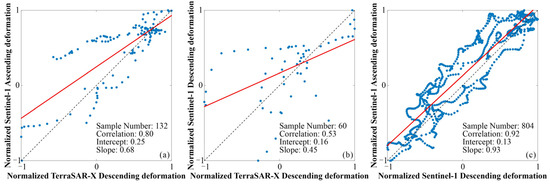
Figure 9.
Correlation analyses of normalized vertical deformations: (a) Sentinel-1 ascending vs. TerraSAR-X descending datasets; (b) Sentinel-1 descending vs. TerraSAR-X descending datasets; (c) Sentinel-1 ascending vs. Sentinel-1 descending datasets. The red line indicates linear fitting, while the black dashed line represents a reference line with zero intercept and a slope of one. Blue dots signify the normalized deformations.
The InSAR time series at the six sites underwent temporal interpolation using spline functions and were subsequently normalized for correlation analysis. The results indicate a generally good consistency among the three datasets. The highest correlation, reaching 0.92, was observed between the Sentinel-1 ascending and descending datasets. The second-best consistency was noted between Sentinel-1 ascending and TerraSAR-X observations, with a correlation exceeding 0.80. However, the correlation between the TerraSAR-X and Sentinel-1 descending datasets was the lowest, measuring 0.53. This lower correlation can be attributed, in part, to the relatively short time overlap between the two datasets, with only 10 samples at each point.
4.5. GNSS Validation
A GNSS monitoring system was established at the SWC Reservoir, comprising one base station and three monitoring sites on the embankment dam. Baseline solutions were calculated to assess deformation at the monitoring sites, TP01, TP02, and TP03. Over a period of nine months in 2017, continuous data were collected from both Beidou and GPS satellites. These data were then used to generate daily displacement time series. For more comprehensive information regarding the GNSS monitoring, please refer to [44].
To validate the accuracy of the InSAR datasets, the GNSS measurements, which included deformations in the north, east, and up directions, were projected into the LOS direction of the SAR satellite. The comparison of the InSAR and GNSS observations is shown in Figure 10.
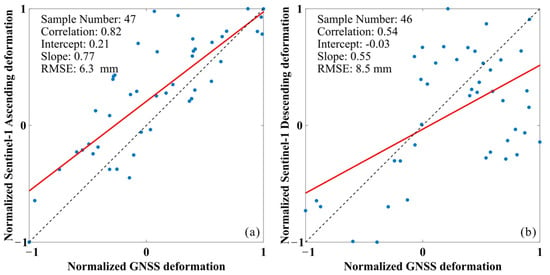
Figure 10.
Comparison of the displacement along the LOS direction as monitored at the GNSS sites and estimated from the InSAR analysis. Correlation of normalized deformations between (a) GNSS and Sentinel-1 ascending observations and (b) GNSS and Sentinel-1 descending observations. The red line indicates linear fitting, while the black dashed line represents a reference line with zero intercept and a slope of one. Blue dots signify the normalized deformations.
The analysis of the three GNSS sites revealed a strong agreement between the GNSS and the Sentinel-1 ascending observations, with a correlation coefficient reaching 0.82. On average, the differences in Sentinel-1 ascending InSAR displacement estimates compared to the GNSS are −3.3 mm, and the Root Mean Square Error (RMSE) is 6.3 mm. While the results obtained by descending observations are slightly less accurate, the correlation also reaches a respectable 0.54, with mean differences and RMSE of 4.2 mm and 8.5 mm, respectively. The sub-centimeter accuracy of Sentinel-1 InSAR time series in comparison to continuous GNSS monitoring is consistent with established InSAR monitoring practices [45,46].
5. Discussion
5.1. Influence of Water Level Changes on Deformation
The deformation of the earth-rock dam is influenced by various factors, including consolidation settlement, changes in the reservoir water level, and seepage conditions within the dam structure [47]. In this study, we acquired water level data for the SWC Reservoir covering the period from January 2016 to June 2018. These data are presented in Figure 11 alongside the corresponding InSAR deformation results for the same time frame.
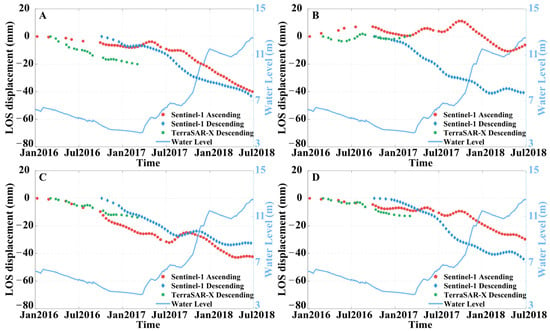
Figure 11.
A comparison of the deformation time series of four locations (A–D) on the dam with the reservoir water level during the same period. Locations A–D are marked in Figure 6c.
It is worth noting that the SWC Reservoir underwent preliminary technical acceptance in June 2013 and successfully completed the acceptance process for the design unit project in October 2018. The water level data we obtained pertains to the experimental water storage inspection phase of the reservoir. During this period, the water level approached the maximum design water level, particularly in the second quarter of 2018, when the SWC Reservoir operated at its full capacity. This marked the first instance of the reservoir being utilized at such a high water level, signifying an important operational milestone.
The water level changes shown in Figure 11 can be roughly divided into two distinct stages. From the beginning of 2016 until the first quarter of 2017, the water level exhibited a downward trend, decreasing from 6.37 m to 4.21 m. Following the onset of experimental water storage in the middle of March 2017, the water level began to rise continuously, increasing by 4.21 m to 12.51 m. Throughout this entire period, the InSAR results consistently indicated that the dam was experiencing ongoing settlement. The monitoring period corresponds to the early stages following the dam’s construction. During this phase, it appears that consolidation settlement is the primary driving factor for dam deformation. While changes in the water level do have an impact on the deformation, this primarily reflects variations in the deformation rates. Nonetheless, it is evident that water level changes are not the governing factor for dam deformation during this period.
5.2. Autumn Flood in 2021
In late September 2021, the lower reaches of the Yellow River experienced the most substantial and extended autumn flood since 1949. This event led to severe autumn flooding in many areas of Shandong Province, characterized by prolonged high water levels and substantial flows, creating a critical flood control situation. To effectively alleviate the flood pressure and maximize the utilization of rainwater resources, the SWC Reservoir began receiving floodwater transfers on 18 October. The filling operation concluded on 26 October, with a total inflow of 7.53 million cubic meters, reaching nearly 15% of the reservoir’s total regulating capacity. Figure 12 illustrates the Sentinel-1 deformation monitoring results for the 2021 flood season (from May to October), with the period of emergency water storage clearly marked.
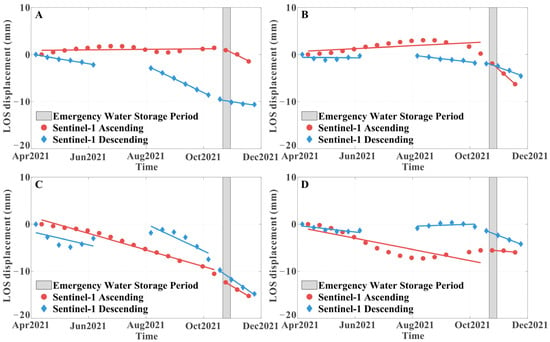
Figure 12.
Subfigures (A–D) are deformation monitoring results for locations A to D on the dam (see Figure 6c) during the flood season (May to October) in 2021 as observed by Sentinel-1. The year 2021 experienced significant autumn floods in October. Emergency water storage operations were implemented from 18 to 26 October to alleviate downstream flood pressure.
Rapid changes in water levels will raise challenges to dam safety. Swift changes in the saturation levels and seepage patterns can introduce risks of slope instability. During periods of rapid water level changes and operations at a high water level, enhanced safety inspections and monitoring are essential. Figure 12 illustrates minor changes in the deformation rate on the dam’s surface before and after the emergency water storage. Thanks to the large area (about 7.8 km2) of the reservoir, the water level rise is minor. Consequently, the impact of this emergency water storage on the dam’s deformation was relatively insignificant. Furthermore, the future deployment of increasingly dense satellite constellation missions will lead to shorter intervals between available revisit data. This improved temporal resolution will significantly enhance the capability to monitor and respond to emergency events.
Although monitoring targets provided by InSAR offer excellent spatial details compared to traditional measurement methods, it has limitations. Due to the satellite imaging geometry, distortion, decorrelation, and image resolution, there are still monitoring blind spots in InSAR results. Combining multi-source and high-resolution SAR images for monitoring could improve this situation in future studies.
6. Conclusions
For long-distance water transfer projects, the safe and stable operation of reservoirs, rivers, canals, and pipelines along the route is crucial. Traditional ground monitoring methods are constrained by their limited spatial resolution and labor-intensive requirements, making them ill-suited to meet the spatiotemporal continuity demands for deformation monitoring. In this study, we utilized multi-temporal InSAR to conduct continuous monitoring over a seven-year period at Shuangwangcheng Reservoir, one of the storage reservoirs situated in the East Route of the South-to-North Water Diversion Project in China.
Our comprehensive analysis encompassed the assessment of imaging geometries in both ascending and descending paths, the examination of the consistency within multi-geometry InSAR deformation time series, and the verification of accuracy through GNSS comparisons. These investigations yielded the following conclusions:
- (1)
- Over a seven-year monitoring period, the SWC Dam experienced settlement, with a cumulative maximum subsidence of ~160 mm occurring at the northeast corner of the embankment. The eastern and southern sections of the embankment dam have undergone substantial subsidence rates, while the northwestern side displays the least deformation. The deformation varied across different sections of the embankment dam, but the gradient was relatively minor due to the dam’s considerable length.
- (2)
- The InSAR time series results from Sentinel-1 ascending, Sentinel-1 descending, and TerraSAR-X descending datasets exhibited a high consistency. The strongest correlation was observed between the Sentinel-1 ascending and descending datasets, reaching 0.92. The second-best correlation was between the Sentinel-1 ascending and TerraSAR-X results at 0.80, while the descending datasets of Sentinel-1 and TerraSAR-X displayed the weakest correlation at 0.53.
- (3)
- GNSS observations at three monitoring sites on the SWC Dam were used to validate the accuracy of InSAR results. The accuracy of Sentinel-1 InSAR time series displacements in the line-of-sight direction was determined to be 6.3 mm for the ascending path data and 8.5 mm for the descending path data.
- (4)
- The deformation of the earth-rock dam is influenced by various factors. A comparison of the InSAR deformation time series with reservoir water levels revealed that while water level changes did impact deformation, consolidation settlement remained the controlling factor during the monitoring period. The SWC Dam is still in the primary consolidation stage.
- (5)
- During the severe autumn floods in 2021, the InSAR results for the SWC Reservoir Dam showed minor changes in the deformation rate before and after emergency water storage. The potential deployment of increasingly dense satellite constellation missions holds promise for enhanced emergency monitoring capabilities.
Author Contributions
Conceptualization, R.X. and S.Y.; software, X.G. and X.W.; validation, Z.W.; resources, R.X.; data curation, X.G.; writing—original draft preparation, X.G. and R.X.; writing—review and editing, R.X.; visualization, X.G. and X.W; supervision, R.X. and X.H.; funding acquisition, R.X., S.Y. and X.H. All authors have read and agreed to the published version of the manuscript.
Funding
This research was funded by the National Natural Science Foundation of China (Grant Nos. 42174018 and 41830110).
Data Availability Statement
Copernicus Sentinel data were downloaded from Alaska Satellite Facility—Distributed Active Archive Center (ASF DAAC, https://vertex.daac.asf.alaska.edu, accessed on 13 November 2023) and processed by the European Space Agency (ESA). The COP-DEM used were retrieved from the ESA Copernicus data hub (https://spacedata.copernicus.eu/, accessed on 13 November 2023).
Acknowledgments
The authors express their gratitude to the European Space Agency for providing the Sentinel-1 data and Copernicus DEM used in this study. The authors are grateful to the High-Performance Computing platform at Hohai University for processing the SAR data in this paper. Additionally, the authors extend their appreciation to the anonymous reviewers for their valuable and constructive comments.
Conflicts of Interest
The authors declare no conflicts of interest. The funders had no role in the design of the study; in the collection, analyses, or interpretation of data; in the writing of the manuscript; or in the decision to publish the results.
References
- Braga, B. Water is a prerequisite for all development. UN Chron. 2018, 55, 41–43. [Google Scholar] [CrossRef]
- State Water Project. Available online: https://water.ca.gov/programs/state-water-project (accessed on 13 December 2023).
- Zhao, Z.-Y.; Zuo, J.; Zillante, G. Transformation of water resource management: A case study of the South-to-North Water Diversion project. J. Clean. Prod. 2017, 163, 136–145. [Google Scholar] [CrossRef]
- Biggs, J.; Wright, T.J. How satellite InSAR has grown from opportunistic science to routine monitoring over the last decade. Nat. Commun. 2020, 11, 3863. [Google Scholar] [CrossRef]
- Berardino, P.; Fornaro, G.; Lanari, R.; Sansosti, E. A new algorithm for surface deformation monitoring based on small baseline differential SAR interferograms. IEEE Trans. Geosci. Remote Sens. 2002, 40, 2375–2383. [Google Scholar] [CrossRef]
- Ferretti, A.; Fumagalli, A.; Novali, F.; Prati, C.; Rocca, F.; Rucci, A. A New Algorithm for Processing Interferometric Data-Stacks: SqueeSAR. IEEE Trans. Geosci. Remote Sens. 2011, 49, 3460–3470. [Google Scholar] [CrossRef]
- Hooper, A. A multi-temporal InSAR method incorporating both persistent scatterer and small baseline approaches. Geophys. Res. Lett. 2008, 35, 4654. [Google Scholar] [CrossRef]
- Lanari, R.; Mora, O.; Manunta, M.; Mallorquí, J.J.; Berardino, P.; Sansosti, E. A small-baseline approach for investigating deformations on full-resolution differential SAR interferograms. IEEE Trans. Geosci. Remote Sens. 2004, 42, 1377–1386. [Google Scholar] [CrossRef]
- Song, C.; Yu, C.; Li, Z.; Utili, S.; Frattini, P.; Crosta, G.; Peng, J. Triggering and recovery of earthquake accelerated landslides in Central Italy revealed by satellite radar observations. Nat. Commun. 2022, 13, 7278. [Google Scholar] [CrossRef]
- Shi, G.; Ma, P.; Hu, X.; Huang, B.; Lin, H. Surface response and subsurface features during the restriction of groundwater exploitation in Suzhou (China) inferred from decadal SAR interferometry. Remote Sens. Environ. 2021, 256, 112327. [Google Scholar] [CrossRef]
- Cigna, F.; Tapete, D. Urban growth and land subsidence: Multi-decadal investigation using human settlement data and satellite InSAR in Morelia, Mexico. Sci. Total Environ. 2022, 811, 152211. [Google Scholar] [CrossRef]
- Xiao, R.; Yu, C.; Li, Z.; He, X. Statistical assessment metrics for InSAR atmospheric correction: Applications to generic atmospheric correction online service for InSAR (GACOS) in Eastern China. Int. J. Appl. Earth Obs. Geoinf. 2021, 96, 102289. [Google Scholar] [CrossRef]
- Tomás, R.; Díaz, E.; Szeibert, W.; Liu, X.; Lopez-Sanchez, J.M.; Zhao, C. Geomorphological characterization, remote sensing monitoring, and modeling of a slow-moving landslide in Alcoy (Southern Spain). Landslides 2023, 20, 1293–1301. [Google Scholar] [CrossRef]
- Xiao, R.; Yu, C.; Li, Z.; Jiang, M.; He, X. InSAR stacking with atmospheric correction for rapid geohazard detection: Applications to ground subsidence and landslides in China. Int. J. Appl. Earth Obs. Geoinf. 2022, 115, 103082. [Google Scholar] [CrossRef]
- Modeste, G.; Doubre, C.; Masson, F. Time evolution of mining-related residual subsidence monitored over a 24-year period using InSAR in southern Alsace, France. Int. J. Appl. Earth Obs. Geoinf. 2021, 102, 102392. [Google Scholar] [CrossRef]
- Wang, G.; Li, P.; Li, Z.; Liang, C.; Wang, H. Coastal subsidence detection and characterization caused by brine mining over the Yellow River Delta using time series InSAR and PCA. Int. J. Appl. Earth Obs. Geoinf. 2022, 114, 103077. [Google Scholar] [CrossRef]
- Hanssen, R.F.; Van Leijen, F.J. Monitoring water defense structures using radar interferometry. In Proceedings of the 2008 IEEE Radar Conference, Rome, Italy, 26–30 May 2008; pp. 1–4. [Google Scholar]
- Liao, M.; Tang, J.; Wang, T.; Balz, T.; Zhang, L. Landslide monitoring with high-resolution SAR data in the Three Gorges region. Sci. China Earth Sci. 2012, 55, 590–601. [Google Scholar] [CrossRef]
- Voege, M.; Frauenfelder, R.; Larsen, Y. Displacement monitoring at Svartevatn dam with interferometric SAR. In Proceedings of the 2012 IEEE International Geoscience and Remote Sensing Symposium, Munich, Germany, 22–27 July 2012; pp. 3895–3898. [Google Scholar]
- Milillo, P.; Bürgmann, R.; Lundgren, P.; Salzer, J.; Perissin, D.; Fielding, E.; Biondi, F.; Milillo, G. Space geodetic monitoring of engineered structures: The ongoing destabilization of the Mosul dam, Iraq. Sci. Rep. 2016, 6, 37408. [Google Scholar] [CrossRef]
- Emadali, L.; Motagh, M.; Haghighi, M.H. Characterizing post-construction settlement of the Masjed-Soleyman embankment dam, Southwest Iran, using TerraSAR-X SpotLight radar imagery. Eng. Struct. 2017, 143, 261–273. [Google Scholar] [CrossRef]
- Al-Husseinawi, Y.; Li, Z.; Clarke, P.; Edwards, S. Evaluation of the stability of the Darbandikhan Dam after the 12 November 2017 Mw 7.3 Sarpol-e Zahab (Iran–Iraq border) earthquake. Remote Sens. 2018, 10, 1426. [Google Scholar] [CrossRef]
- Li, T.; Motagh, M.; Wang, M.; Zhang, W.; Gong, C.; Xiong, X.; He, J.; Chen, L.; Liu, J. Earth and rock-filled dam monitoring by high-resolution X-band interferometry: Gongming dam case study. Remote Sens. 2019, 11, 246. [Google Scholar] [CrossRef]
- Xie, L.; Xu, W.; Ding, X. Precursory motion and deformation mechanism of the 2018 Xe Pian-Xe Namnoy dam Collapse, Laos: Insights from satellite radar interferometry. Int. J. Appl. Earth Obs. Geoinf. 2022, 109, 102797. [Google Scholar] [CrossRef]
- Xiao, R.; Jiang, M.; Li, Z.; He, X. New insights into the 2020 Sardoba dam failure in Uzbekistan from Earth observation. Int. J. Appl. Earth Obs. Geoinf. 2022, 107, 102705. [Google Scholar] [CrossRef]
- Mishra, V.; Jain, K. Satellite based assessment of artificial reservoir induced landslides in data scarce environment: A case study of Baglihar reservoir in India. J. Appl. Geophys. 2022, 205, 104754. [Google Scholar] [CrossRef]
- Zhu, Y.; Yao, X.; Yao, L.; Zhou, Z.; Ren, K.; Li, L.; Yao, C.; Gu, Z. Identifying the mechanism of toppling deformation by InSAR: A case study in Xiluodu reservoir, Jinsha river. Landslides 2022, 19, 2311–2327. [Google Scholar] [CrossRef]
- Li, L.; Wen, B.; Yao, X.; Zhou, Z.; Zhu, Y. InSAR-based method for monitoring the long-time evolutions and spatial-temporal distributions of unstable slopes with the impact of water-level fluctuation: A case study in the Xiluodu reservoir. Remote Sens. Environ. 2023, 295, 113686. [Google Scholar] [CrossRef]
- China’s Mega Water Diversion Project Benefits over 150 mln People. Available online: http://en.people.cn/n3/2023/0515/c90000-20018237.html (accessed on 14 October 2023).
- Rogers, S.; Chen, D.; Jiang, H.; Rutherfurd, I.; Wang, M.; Webber, M.; Crow-Miller, B.; Barnett, J.; Finlayson, B.; Jiang, M. An integrated assessment of China’s South—North water transfer project. Geogr. Res. 2020, 58, 49–63. [Google Scholar] [CrossRef]
- Long, D.; Yang, W.T.; Scanlon, B.R.; Zhao, J.S.; Liu, D.G.; Burek, P.; Pan, Y.; You, L.Z.; Wada, Y. South-to-North Water Diversion stabilizing Beijing’s groundwater levels. Nat. Commun. 2020, 11, 1–10. [Google Scholar] [CrossRef]
- Yan, H.; Lin, Y.; Chen, Q.; Zhang, J.; He, S.; Feng, T.; Wang, Z.; Chen, C.; Ding, J. A Review of the Eco-Environmental Impacts of the South-to-North Water Diversion: Implications for Interbasin Water Transfers. Engineering 2023, in press. [CrossRef]
- Copernicus DEM. 2021. Available online: https://spacedata.copernicus.eu/en/web/guest/collections/copernicus-digital-elevation-model (accessed on 29 August 2023).
- Hooper, A.; Segall, P.; Zebker, H. Persistent scatterer interferometric synthetic aperture radar for crustal deformation analysis, with application to Volcán Alcedo, Galápagos. J. Geophys. Res. Solid Earth 2007, 112, 4763. [Google Scholar] [CrossRef]
- Jiang, M. Sentinel-1 TOPS co-registration over low-coherence areas and its application to velocity estimation using the all pairs shortest path algorithm. J. Geod. 2020, 94, 1–15. [Google Scholar] [CrossRef]
- Eineder, M.; Hubig, M.; Milcke, B. Unwrapping large interferograms using the minimum cost flow algorithm. In Proceedings of the IGARSS’98. Sensing and Managing the Environment. 1998 IEEE International Geoscience and Remote Sensing, Symposium Proceedings (Cat. No. 98CH36174), Seattle, WA, USA, 6–10 July 1998; pp. 83–87. [Google Scholar]
- Morishita, Y.; Lazecky, M.; Wright, T.J.; Weiss, J.R.; Elliott, J.R.; Hooper, A. LiCSBAS: An open-source InSAR time series analysis package integrated with the LiCSAR automated Sentinel-1 InSAR processor. Remote Sens. 2020, 12, 424. [Google Scholar] [CrossRef]
- Chen, C.W.; Zebker, H.A. Phase unwrapping for large SAR interferograms: Statistical segmentation and generalized network models. IEEE Trans. Geosci. Remote Sens. 2002, 40, 1709–1719. [Google Scholar] [CrossRef]
- Wright, T.J.; Parsons, B.E.; Lu, Z. Toward mapping surface deformation in three dimensions using InSAR. Geophys. Res. Lett. 2004, 31, 169–178. [Google Scholar] [CrossRef]
- Qu, X.; Shi, L.; Qu, X.; Qiu, M.; Gao, W.; Wang, J. Evaluation of Groundwater Resources and Exploitation Potential: A Case from Weifang City of Shandong Province in China. ACS Omega 2021, 6, 10592–10606. [Google Scholar] [CrossRef] [PubMed]
- Li, F.; Sun, Q.; Wang, W.; Qu, S.; Ni, L.; Wang, C. Changes of virtual water trade based on input-output model in Shandong Province and environment response in representative region. In Proceedings of the IOP Conference Series: Earth and Environmental Science, Guiyang, China, 14–16 June 2019; p. 052059. [Google Scholar]
- Wang, K.; Chen, H.; Fu, S.; Li, F.; Wu, Z.; Xu, D. Analysis of exploitation control in typical groundwater over-exploited area in North China Plain. Hydrol. Sci. J. 2021, 66, 851–861. [Google Scholar] [CrossRef]
- DS-13(9)-17; Design Standards No. 13 Embankment Dams, Chapter 9: Static Deformation Analysis Phase 4 (Final). U.S. Department of the Interior, Bureau of Reclamation: Denver, CO, USA, 2011.
- Xiao, R.; Shi, H.; He, X.; Li, Z.; Jia, D.; Yang, Z. Deformation monitoring of reservoir dams using GNSS: An application to south-to-north water diversion project, China. IEEE Access 2019, 7, 54981–54992. [Google Scholar] [CrossRef]
- Cigna, F.; Ramírez, R.E.; Tapete, D. Accuracy of Sentinel-1 PSI and SBAS InSAR Displacement Velocities against GNSS and Geodetic Leveling Monitoring Data. Remote Sens. 2021, 13, 4800. [Google Scholar] [CrossRef]
- Manunta, M.; De Luca, C.; Zinno, I.; Casu, F.; Manzo, M.; Bonano, M.; Fusco, A.; Pepe, A.; Onorato, G.; Berardino, P. The Parallel SBAS Approach for Sentinel-1 Interferometric Wide Swath Deformation Time-Series Generation: Algorithm Description and Products Quality Assessment. IEEE Trans. Geosci. Remote. Sens. 2019, 57, 6259–6281. [Google Scholar] [CrossRef]
- Fell, R.; MacGregor, P.; Stapledon, D.; Bell, G.; Foster, M. Geotechnical Engineering of Dams, 2nd ed.; CRC Press: London, UK, 2014. [Google Scholar]
Disclaimer/Publisher’s Note: The statements, opinions and data contained in all publications are solely those of the individual author(s) and contributor(s) and not of MDPI and/or the editor(s). MDPI and/or the editor(s) disclaim responsibility for any injury to people or property resulting from any ideas, methods, instructions or products referred to in the content. |
© 2024 by the authors. Licensee MDPI, Basel, Switzerland. This article is an open access article distributed under the terms and conditions of the Creative Commons Attribution (CC BY) license (https://creativecommons.org/licenses/by/4.0/).